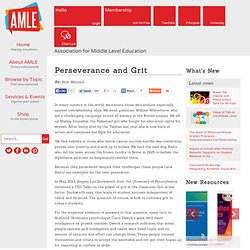

Perseverance and Grit. In every country in the world, we elevate those who endure, especially against overwhelming odds.

We exalt politician William Wilberforce, who led a challenging campaign to end all slavery in the British empire. We lift up Malala Yousafzai, the Pakastani girl who fought for education rights for women. After being shot by the Taliban last year, she is now back in action and continues her fight for education. We find nobility in those who battle cancer, survive horrific war conditions, prevail over poverty, and stand up to bullies. We laud the sled dog, Balto, who led his team across the frozen tundra to Nome in 1925 to deliver the diphtheria antitoxin so desperately needed there.
Because they persevered despite their challenges, these people (and Balto) are examples for the next generation. In May 2013, Angela Lee Duckworth from the University of Pennsylvania delivered a TED Talks on the power of grit in the classroom. How to Revitalize Your Students. Have I let "instructional weeds" infest my classroom?

I went out into my backyard today and was astounded about its condition. The hibernating Bermuda grass was yellow-brown as it should have been, but salt-and-peppered throughout the yard were bright green dandelions with the "I dare you to stop me" fluffy white seed flowers that had not been there in the fall. I thought I had eradicated them completely last summer, but the evidence was plain to see. My yard was infested once again with those obnoxious dandelions that grow so quickly and so effortlessly. So what are the instructional weeds in my classroom? Yes, I could blame the students for their behaviors or I could look at what I have been doing to allow these pesky learning inhibiting weeds to germinate and grow. True Grit: The Best Measure of Success and How to Teach It. Can you predict academic success or whether a child will graduate?

You can, but not how you might think. When psychologist Angela Duckworth studied people in various challenging situations, including National Spelling Bee participants, rookie teachers in tough neighborhoods, and West Point cadets, she found: One characteristic emerged as a significant predictor of success. 10 Tips for Giving Feedback That Will Build a Team You Love to Work With. You will find that you love working with your team when you commit to supporting and developing their work and their growth.

The only way to do this? Give excellent feedback. Here are 10 critical tips every manager must use to build a team that is a pleasure to work with: 1. Your feedback is your product. If you are a master brewer, you put time, energy, and expertise into creating the best beer possible. 2. Technically, it’s not feedback unless you gave your team clear expectations. If you recognize that clear expectations are missing in your team, it’s not too late. 3. Giving positive feedback reinforces the foundation of any working relationship. It has been proven in multiple research studies that the most effective feedback is given in a ratio of at least seven positives to one corrective message. Develop a habit of giving specific positive feedback as a habit. 5 Steps to Foster Grit in the Classroom. Photo credit: iStockphoto The word "grit" suggests toughness and determination.

The question is how do we get students to value struggle, failure and perseverance in our classrooms? ASCD recently published Thomas Hoerr's short but great book on this subject, Fostering Grit. The subtitle "How do I prepare my students for the real world? " reflects the fact that our students will encounter challenging work and problems to solve. Model Grit Modeling is a crucial component in teaching skills to students. Don't Grade Formative Assessments.
The Five-by-Five Approach to Differentiation Success. Published Online: January 17, 2012 By Katie Hull-Sypnieski and Larry Ferlazzo Two 9th grade boys kept falling asleep while reading.

The day i passed maths. Kids Speak Out on Student Engagement. A while back, I was asked, "What engages students? " Sure, I could respond, sharing anecdotes about what I believed to be engaging, but I thought it would be so much better to lob that question to my own eighth graders. 41175554. Flickr. Summer2011. Four Ways to Increase Student Engagement. Recently, I asked a faculty focus group what they hear students “say” in class.

The top answers didn’t surprise me, but they did reveal a pattern in kids today: “I’m bored.” “This is too hard.” “Will this be on the test?” “What does this have to do with my life?” Granted, these are honest statements made by teenagers. Four Changes We Can Make I just completed a qualitative study among students in higher education institutions. Story vs. Did you catch that? Based upon our research, we’ve just released a new resource for educators to use as they equip young leaders on campus. It is a series of case studies, containing relevant stories (item one above), about students who faced a dilemma as a young leader. The case studies include scenarios with Resident Advisors, Student Government Officers, Club Leaders, Peer Mentors and other leadership roles. I recently had a teacher ask me what to do about today’s entertainment-addicted student. Photo credit: dcJohn via photopin cc.